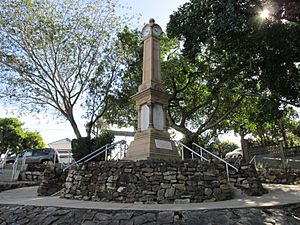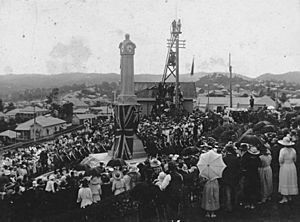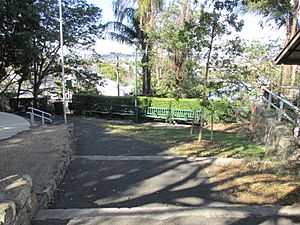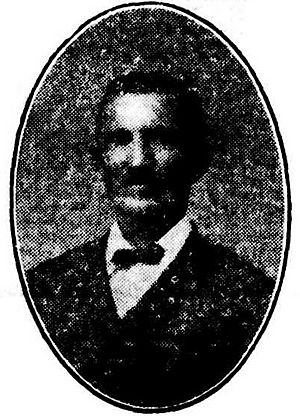Ithaca War Memorial facts for kids
Quick facts for kids Ithaca War Memorial |
|
|---|---|

Ithaca War Memorial, 2014
|
|
| Location | Enoggera Terrace, Paddington, Queensland, Australia |
| Design period | 1919–1930s (interwar period) |
| Built | 1921–1925 |
| Built for | Town of Ithaca |
| Architect | Arthur Henry Thurlow, Alexander Jolly |
| Owner | Brisbane City Council |
| Official name: Ithaca War Memorial and Park, Alexander Jolly Park | |
| Type | state heritage (built, landscape) |
| Designated | 21 October 1992 |
| Reference no. | 600274 |
| Significant period | 1921–(social) 1921–1925 |
| Significant components | garden – bed/s, clock, trees/plantings, memorial – clock tower, pathway/walkway, wall/s – retaining |
| Builders | Arthur Henry Thurlow, Alexander Jolly |
| Lua error in Module:Location_map at line 420: attempt to index field 'wikibase' (a nil value). | |
The Ithaca War Memorial and Park is a special place in Paddington, Queensland, Australia. It remembers the brave soldiers from the Town of Ithaca who served in wars. This important memorial was designed by Arthur Henry Thurlow between 1921 and 1925. The beautiful park around it was created by Alexander Jolly. It is also known as Alexander Jolly Park. This important site was added to the Queensland Heritage Register on 21 October 1992.
Contents
History of the Ithaca War Memorial
The Ithaca War Memorial and Park was created around 1922. A special committee worked on behalf of the people of the Town of Ithaca. The main monument was designed and built by a company called Arthur Henry Thurlow. The park was designed by Alexander Jolly, who was the landscape gardener for the Ithaca Town Council.
Planning the Memorial
The idea for a memorial began as early as October 1915. In February 1916, an "honour board" was shown. This board listed the names of people from Ithaca who had joined the war. It was meant to be placed in the Ithaca Town Council Chambers.
By January 1917, the honour board had over 600 names. However, people wanted a more public way to remember those who served. In October 1917, there was a plan to plant trees as a memorial. But these plans were stopped in January 1918. The Queensland Government did not allow fundraising for memorials while the war was still happening.
Building the Memorial
After the war ended on 11 November 1918, the idea for a memorial came back. The Town Council thought about planting trees again. Each tree would remember a person who died in the war.
By late 1919, money was being collected for the memorial. The Town Council promised to add 20% to the money raised by residents. People held donations, fetes, and concerts to collect funds. By June 1921, enough money (about £650) was raised to start designing the memorial.
The Returned and Services League of Australia suggested building a memorial hall. They thought it would be more useful than a monument. But the Town Council worried about the cost of keeping a hall running. In July 1921, they decided to build a monument instead. It would be placed on Cook's Hill and have the names of the fallen soldiers carved on it.
The Ithaca War Memorial was officially shown to the public on 25 February 1922. Sir Matthew Nathan, who was the Governor of Queensland, unveiled it. The local community raised all the money for the memorial. It cost about £650. The stone memorial honours 130 local men who died during the First World War.
Many different types of war memorials were built in Queensland. However, clock towers were quite rare. The memorial at Ithaca is the first of its kind. It is also the only clock tower memorial in Brisbane. The clock was made by the Synchronome Electric Company of Brisbane. It was first powered by a main clock in the nearby Ithaca Fire Station.
Creating the Park
The park is located on a piece of land between Enoggera and Latrobe Terraces. This area was originally meant for a road. But by 1922, it was clear it wouldn't be used for a road. A path beside the park still links Enoggera and Latrobe Terraces.
In the early 1900s, Ithaca grew a lot. More people moved there because tram lines were built. In the 1910s, the Ithaca Town Council started improving the area. They built roads, planted trees, and created many gardens.
Because the area was hilly, many new streets had steep banks. The Council found it cheaper to plant gardens on these banks than to cut them down. This new way of landscaping made other councils interested. They asked for photos and plans of Ithaca's street improvements. The War Memorial Park is one of the few areas from this time that still exists.
The park's landscaping was done by Alexander Jolly. He was the landscape gardener for the Ithaca Town Council. Alexander Jolly was the father of William Jolly, who became the first Mayor of Greater Brisbane. Jolly was a self-taught gardener. He arrived in Brisbane in 1879 when he was 22. He worked as a head gardener before joining the Ithaca Town Council.
Jolly's gardening skills changed the look of Ithaca between 1915 and 1925. Other works by Jolly included rock gardens along Musgrave and Waterworks Roads. After he died in March 1925, the memorial park was renamed Alexander Jolly Park. This was to remember him as a respected man and to honour his hard work.
The Alexander Jolly Park, now called Ithaca Memorial Park, has been looked after by the Brisbane City Council since 1925.
Why War Memorials Are Important
Before the First World War, Australia had few public monuments. The memorials built after this war became our first national monuments. They show the huge impact the war had on our young country. Australia lost 60,000 people from a population of about 4 million. This means one in five of those who served died. No other war has affected Australia as much.
Even before the war ended, memorials became a way to show national sadness. For those who built them, they were like sacred graves. They were substitute graves for Australians whose bodies were buried in battlefields far away. The word "cenotaph" means "empty tomb."
Australian war memorials are special because they don't just remember the dead. Australians were proud that their first big army was made up entirely of volunteers. These men were honoured whether they died or not. Many memorials honour everyone from a local area who served, not just those who died. This helps us understand how communities were involved in the war.
Australian war memorials also show our loyalty to the British Empire and our own nation. They show the skills of local stonemasons, metalworkers, and architects. In Queensland, statues of soldiers were popular memorials. In southern states, tall, pointed monuments called obelisks were more common.
Many First World War monuments have been updated to include later conflicts. Some have been moved or repaired in ways that changed their original look.
What the Memorial Looks Like
Ithaca Memorial Park is on a sloping hill. It faces Enoggera Terrace at the top and has a steep bank down to Latrobe Terrace below. A paved path leads down to Latrobe Terrace. Another paved path goes around the memorial to Enoggera Terrace. The park has two large fig trees and a planted bank going down to Latrobe Terrace.
The First World War Memorial has a base and a tall pillar. On top of the pillar is a clock with a face on all four sides. It stands on a square concrete area. It is surrounded by stone walls and a concrete path. Steps lead to the memorial from all four sides, forming a cross shape. The design is made softer by plants, walls, and the sloping ground.
The memorial is made of sandstone. It has a smooth base step, then a larger step of sandstone blocks. On the front of this is a marble plaque. The main part of the memorial has a square pillar with columns at each corner. Each side has a marble plate with the names of the 130 men who died. The columns have fancy tops and bottoms. They hold up a large decorative section called an entablature. This section has carved decorations and a small row of blocks under the top edge.
Above this is another square pillar. Each side has a curved space with the word "Ithaca" carved into it. Above this is the clock tower itself. Each side has a carved panel. On the side facing Enoggera Terrace, there are two carved flags with the words "Honour the Brave" below. The very top of the memorial is rounded and has a sandstone ball on it.
Why the Memorial is Heritage Listed
The Ithaca War Memorial and Park was added to the Queensland Heritage Register on 21 October 1992. This means it is important for several reasons:
- It shows how Queensland's history has changed.
War memorials show a common part of Queensland's history. They are proof of a time when people felt very patriotic and nationalistic, especially during and after the First World War.
- It shows rare or special parts of Queensland's culture.
It is rare because it is the earliest example of a clock tower memorial.
- It shows the main features of this type of historical place.
The memorial was built around 1922. It shows what a monument built to remember a major historical event should look like. It uses the right materials and design to do this.
- It is beautiful and important to look at.
The memorial's beauty and its important location add to the look of Paddington.
- It has a strong connection to the community.
It has a strong and ongoing connection with the community. It reminds people of a major historical event and is a place for remembrance. The park also has special links to landscape gardener Alexander Jolly, as it is one of the few remaining examples of his work. It also connects to the company A H Thurlow, who built the monument.




